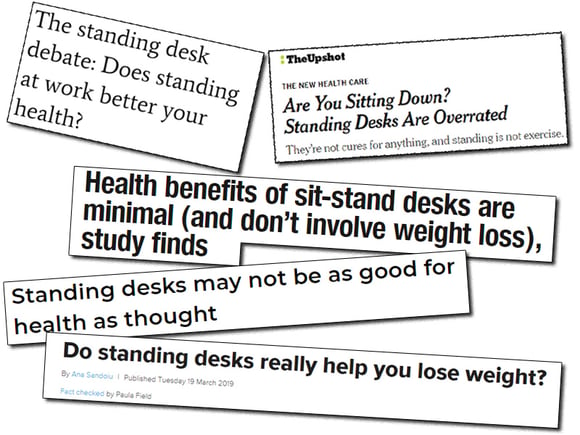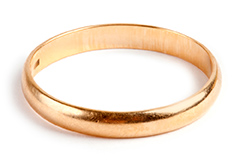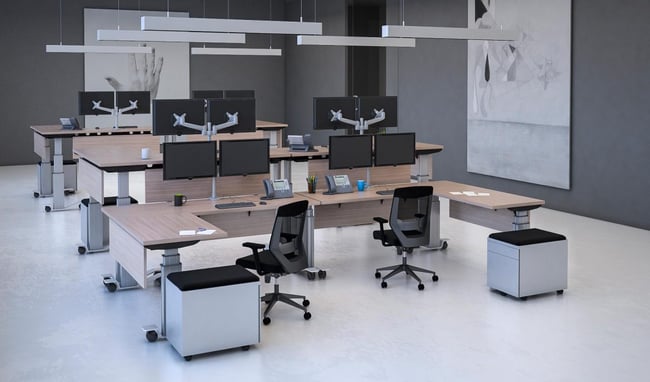During the last several decades, studies told us how bad eggs, sugar, and butter are for our health. Then several years after those studies, new ones declared that eggs, sugar, and butter are good for us.
How in the world are we supposed to know what's good for us when experts keep changing the rules?
Lately, that's been the pattern for reportage on standing desks. When Dr. James Levine published his research, it started a revolution leading to standing desks.
We learned chairs were killing us, so we started using standing desks for their benefits.
Standing Desks: Hero or Fraud?
Proponents of standing desks claim desks reduce obesity, burn calories, and help those with back problems. While, at the same time, they declared sitting is the new smoking.
Cue the bandwagon. Here comes the frenzy.
Suddenly, standing desks grew in importance because of the early efforts of European companies. Following their lead, many other office furniture manufacturers, such as RightAngle Products, Steelcase, Autonomous, HAT, and HON started their lines of standing desks.
People enjoyed their standing desks.
All was right in the world.
When suddenly, it wasn't.
Backlash
There’s been a spate of articles declaring standing desks may do more harm than good while reducing productivity.

In a matter of a few articles, desk jockeys like us find ourselves in a crossfire between these two trains of thought.
Standing Desks are Overrated!

Among the headlines above, one article stood out. TheUpshot, a New Your Times publication, quoted Aaron Carroll, professor of pediatrics at Indiana University School of Medicine, who declared standing desks are overrated.
Research suggests that warnings about sitting at work are overblown and that standing desks are overrated as a way to improve health.
Dr. David Rempel, a professor of medicine at the University of California, San Francisco, who has written on this issue, said, “Well-meaning safety professionals and some office furniture manufacturers are pushing sit-stand workstations as a way of improving cardiovascular health — but there is no scientific evidence to support this recommendation.”
Dr. Rempel warned alternating between sitting and standing helps some people with neck or low back pain. But,
...people shouldn’t be under the illusion that they’re getting exercise.
Of all the articles I read researching this article, Carroll performed the most significant amount of research. In his article, he cited nine different studies arguing how standing desks have become the latest miracle drug.
Admittedly, Carroll writes, too much sitting during the day isn't healthy, but standing doesn't count as exercise.
He's right. But, is that the whole story? In his article, Carroll wrote context matters. Sitting may not be the problem; underlying conditions influence decisions people make.
Zero demographic and societal conditions didn't receive consideration.
Most studies didn't specify if people are unemployed, poor, factory workers, office workers, or people working from home.
Standing Desks Villain!

Although many studies dispel the benefits of a standing desk, I'm only going to show one example for the sake of brevity.
According to a study shared in the June 2016 edition of the Journal of Physical Activity and Health, there wasn't much difference in the number of calories burned between sitting and standing.
More unexpected, standing up was barely more demanding. While standing for 15 minutes, the volunteers burned about two additional calories compared to when they sat down. It didn’t matter whether they stood up and then sat down or sat down and then stood up. The total caloric expenditure was about the same and was not sizable.
The lead author of the study, Seth Creasy, said if your goal is controlling your weight at work, standing may not be enough. Creasy recommended incorporating walking into your daily routine.
Standing Desks Hero!
Offsetting that study is this from the European Journal of Preventive Cardiology. According to this study, people standing burn an extra .15 calories per minute compared to those sitting.
The math works out to losing five pounds or more in a year.

Curiously, many authors writing negative stories also seem to use the same source.
One Source Controlling Them All

According to Mary Chris Jaklevic, reporter-editor for the HealthNewsReview website, one person is the basis for most of the studies critical of standing desks.
A physiotherapy expert at Nottingham University, Alan Taylor, created waves when declaring standing desks are overrated and may be bad for you.
Taylor said current evidence shows drawbacks to standing desks. Instead of investing in a standing desk, he said, take walking breaks (emphasis mine).
For the new study, conducted at Curtin University in Australia, 20 people were observed during two hours of laboratory-based standing computer work. The researchers examined levels of discomfort and cognitive function, along with muscle fatigue, movement, lower limb swelling, and mental state.
I have a simple question: how in the world would a single set of two-hour study sessions of 20 people influence publications throughout the globe?
Critically speaking, Taylor's studies fell short of a thorough examination.
- Taylor didn't address the impact of alternating between standing and sitting.
- The study didn't include people standing on uneven or cushioned surfaces allowing them to shift position.
- No comparison to a group of people doing different things, such as using a treadmill or merely sitting, was included in the study.
Later in her article, Jaklevic asked David Hall, an occupational health chair at the Australian Physiotherapy Association, about Taylor’s work. He had a two-word answer: "Highly Predictable."
Because of the small sample sizes and limited testing duration, Hall said, it's easy predicting the results of Taylor's study.
Taylor's results showed short-term aches in the lab. The media, however, ran with unsupported conclusions that standing desks were harmful.
Overlooking the Obvious
While writing, I found many articles supporting both sides of the issue. However, there was no gray area:
- People calling standing desks critical to your health kept pushing the healthy benefits of standing while working.
- People calling standing desks overrated kept referring to incomplete studies.
- There was one common theme throughout the articles: move to break up your routine.
The one solution most parties overlooked? Use height adjustable desks!

Standing Desks
Require Patience
By slowly working into a routine while using
a standing desk you allow your body to adjust to
changes. Otherwise, pain and stiffness
stops you from the benefits
A Perfect Compromise

Adjustable height desks provide that happy medium both sides ignored.
The laws of unintended consequences worked its way inside this situation by making sit-to-stand desks the perfect compromise.

The benefits of using a sit-to-stand desk are now common knowledge.
It's considering these benefits that opened Pandora's Box in the office furniture industry.
Once the concept of sit-to-stand desks hit the open market, dozens of companies started making or selling them.
Creating Routine
Getting into a daily routine with your sit-to-stand desk takes a little time. With all the desk recommendations found online, remember that you know what works best for you.
Consider people with orthopedic problems, weight issues, pregnancy, and physical fitness have different needs. Take into account your physical limitations.
There are no official health proclamations on how often to sit or stand each day. However, in general, experts recommend breaking up your day to add two hours of standing for improving any health benefits.
What Does All of This Mean?
Most of the time, when two sides disagree, the truth lies somewhere in the middle.
One Side: Are standing desks the new miracle drug? For some people, yes.
Side Two: Standing desks are overrated? In some circumstances, yes.
But, it’s wrong to discount something helping a great many people summarily. Remember what Carroll wrote in his article: Context Matters.
Using a standing desk is a personal decision. Somebody else can't tell you what works for you, that's something you need to determine.
Consider the context of how you'll be using the desk.
- Do you sit all day?
- Do you have the flexibility of leaving your desk to move around?
In other words, don't take one side over another when deciding. Do some digging to get a complete picture of what people are talking about. Add your limitations to the context of #StandingDesks.
In the end, it boils down to what works for you.


COMMENTS